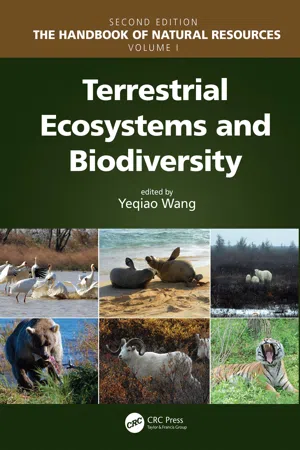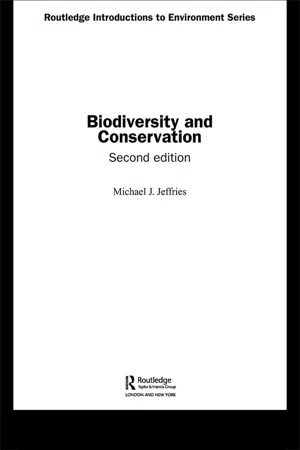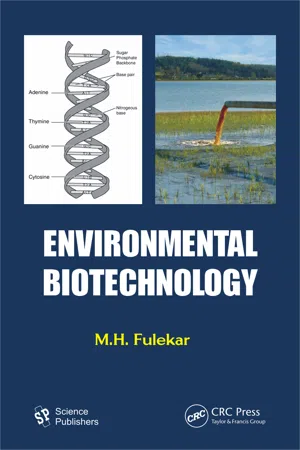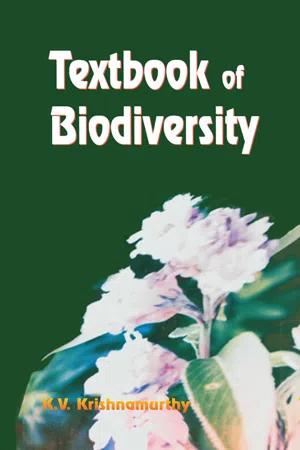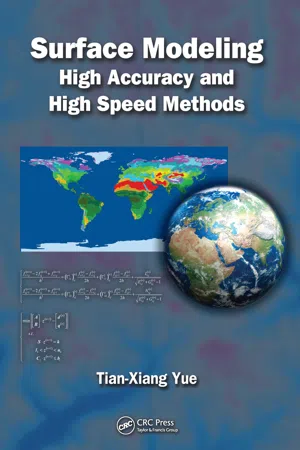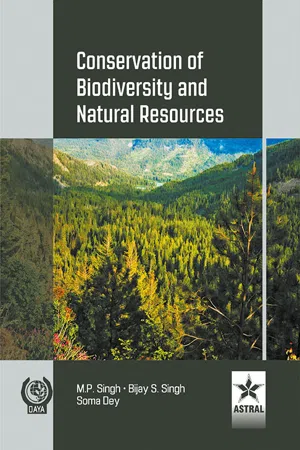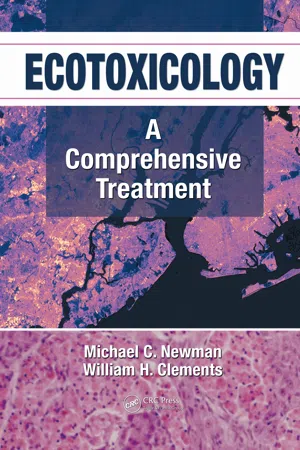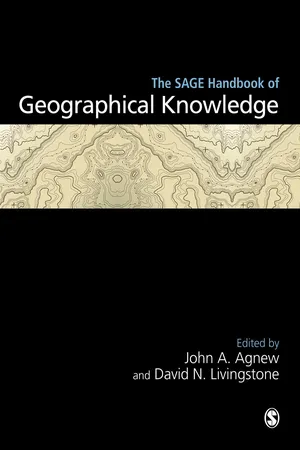Geography
Ecosystem Diversity
Ecosystem diversity refers to the variety of different ecosystems within a specific area. It encompasses the range of habitats, communities, and ecological processes present, including forests, grasslands, wetlands, and marine environments. Ecosystem diversity is important for maintaining ecological balance, supporting biodiversity, and providing essential ecosystem services such as water purification, pollination, and climate regulation.
Written by Perlego with AI-assistance
Related key terms
1 of 5
12 Key excerpts on "Ecosystem Diversity"
- eBook - ePub
- Yeqiao Wang(Author)
- 2020(Publication Date)
- CRC Press(Publisher)
[8] such as a pond in a forest with adjacent grassland. Although borders between ecosystems may be clear and well defined, such as a freshwater lake, the transition from one ecosystem to another can also be gradual. Compared with aquatic ecosystems, in particular marine ecosystems, terrestrial ecosystems are characterized by greater light availability, higher gaseous concentration, lower water content, and greater seasonal and diurnal temperature fluctuations.Biodiversity at the Ecosystem Level
Ecological diversity refers to the species richness in a biological community—it is the diversity of a site at the level of the ecosystem. Together with genetic and species diversity, it forms the third level of biodiversity. In general, the diversity and functional complexity of an ecosystem are governed by the population and diversity of the species that are present, the interactions between these species and their interactions with the environment, and the complexity of the physical environment.[9]The diversity of interacting types at the species or population level maintains ecological complexity and stability. It is known that species diversity has pronounced effects on ecosystem structures and functions. However, ecosystems are dynamic in the sense that they experience periodic perturbations from external forces such as environmental stochasticity and catastrophic events, and internal processes such as nutrient cycling. They have the capacity of resistance and/or resilience to disturbances, which is a function of their ecological attributes. Seasonality is a driving force behind annual changes in community composition and is important in shaping the life history of individual species in terms of breeding behavior and habits. Plant and animal communities constantly and gradually alter and develop over time through a directional, non-seasonal process called succession, as a result of endogenic processes and exogenic influences, thus changing the diversity and structural complexity of the ecosystem. Succession drives natural ecosystem development and assists in ecosystem restoration, which can be manipulated with human interference. Primary succession occurs naturally on glacier moraines or volcanic ashes, which are changed by weathering, plant colonization, organic matter accumulation, and soil formation, which subsequently affect the community and ecosystem levels. - eBook - ePub
- E. Somasundaram, D. Udhaya Nandhini, M. Meyyappan(Authors)
- 2021(Publication Date)
- CRC Press(Publisher)
India is among the world’s 15 nations that are exceptionally rich in species diversity. The earth’s biodiversity is distributed in specific ecological regions. There are over a thousand major eco-regions in the world. Of these, 200 are said to be the richest, rarest and most distinctive natural areas. These areas are referred to as the Global 200. It has been estimated that 50,000 endemic plants which comprise 20% of global plant life, probably occur in only 25 ‘hotspots’ in the world. These hotspots harbor many rare and endangered species. Two criteria help in defining hotspots namely rich endemism and the degree of threat. To qualify as hotspots an area must contain at least 0.5 per cent or 1500 of the worlds 3, 00,000 plants species as endemics. Organic farms are also more likely to have higher agro-biodiversity with greater crop rotation diversity, number of cultivated crops and grassland composition. c) Ecosystem Diversity An ecosystem is made up of the organisms of a particular habitat, such as a farm or forest, together with the physical landscape in which they live. There are a large variety of different ecosystem on earth, each having their own complement of distinctive inter linked species based on differences in the habitat. Ecosystem Diversity can be described for a specific geographical region or a political entity such as a country, a state or a taluk. Distinctive ecosystems include landscapes like forests, grasslands, deserts, mountains etc as well as aquatic ecosystems like rivers, lakes and seas. Each region also has man- modified areas such as farmland or grazing pastures. It refers to the variation in the structure and functions of the ecosystem. It describes the number of niches, trophic levels and various ecological processes that sustain energy flow, flood webs and the recycling of nutrients - eBook - ePub
- Michael J. Jeffries(Author)
- 2006(Publication Date)
- Routledge(Publisher)
concept with species defined as the smallest population (sexual) or lineage (asexual) diagnostically distinct from other such populations and with a discrete lineage. The diagnostic characters are often genetic. When applied to species recognised by morphological or biological concept criteria, the sheer genetic diversity within species often suggests they should be splintered into many separate lineages. The evolutionary concept defines a species by a single, distinct lineage with an identifiable evolutionary history and fate.Ecological diversity
Taxonomic diversity classifies types of organisms and their relatedness but organisms do not live in isolation from one another or the physical world. Humans have long recognised different ecosystems of apparently interdependent life. Ecological science focuses on these patterns and processes, hence ecological diversity is the inclusive term for this third category.Ecological diversity covers a host of concepts; ecosystems, communities, assemblages, habitats, biomes and biogeographical regions. These are not one and the same, indeed some may not be biodiversity proper. The term ecosystem embraces the living organisms and non-living (abiotic) features such as climate and geology of a site. Some have argued that the inclusion of abiotic components excludes ecosystems from biodiversity. A community refers to organisms living together, essentially the live component of an ecosystem. Again this deceptively simple idea is problematic. The term implies a linkage, an interdependence of species that may not exist. Even tightly linked communities will harbour fleeting tourist species, moving through without necessarily playing any role whilst other communities may be very loosely tied assortments, often described as an assemblage. Habitat conjures up precise images such as the giant panda habitat, but the term may not mean anything if the species is not present; does giant panda habitat cease to exist should the giant panda become extinct? Biome is the term associated with global or continental scale, regional ecosystems defined by vegetation and fauna, in its turn largely determined by climate. A formation - eBook - PDF
- M. H. Fulekar(Author)
- 2010(Publication Date)
- CRC Press(Publisher)
Gamma-diversity or geographical diversity: For ecologists, biodiversity is also the diversity of durable interactions among species; their immediate environment (bio type) and also their eco-region. In each ecosystem, living organisms are part of a whole, interacting with not only other organisms, but also with the air, water and soil that surround them. Biodiversity is a broad concept, so a variety of objective measures have been created in order to empirically measure biodiversity. 2.3 BIODIVERSITY CONCEPT The sequel to the first biodiversity book, naturally titled Biodiversity II , documents the rapid rise of the term ‘biodiversity’ in importance and influence. But it also traces the study of aspects of biodiversity as far back as Aristotle. To some extent, biodiversity merely offers a new, emotive, term for some older ideas and programmes. In fact, ‘biodiversity’ is now used sometimes to mean ‘life’ or ‘wilderness’ or other conservation values. ‘Biodiversity’ also has served on occasion as a catch-all for ‘conservation’ itself. The scientific literature illustrates how almost any conservation activity might use the label ‘biodiversity’. On the one hand, workers taking advantage of the acknowledged importance of the term have expanded its meaning to capture concerns at a fine scale, such as that focussing on a favourite single species. This focus might be referred to more accurately as one of ‘biospecifics’. At the coarser scale, one important interpretation, discussed below, advocates a primary linkage of biodiversity to the maintenance of ecosystem processes—what might be called the ‘bio-processes’ approach. The nub of the problem in defining biodiversity is that it is hard to exclude anything from a concept that is taken so easily to mean ‘everything’. - eBook - PDF
Agroecology
The Ecology of Sustainable Food Systems, Third Edition
- Stephen R. Gliessman(Author)
- 2014(Publication Date)
- CRC Press(Publisher)
These methods rely on increasing agroEcosystem Diversity and complexity as a foundation for establishing beneficial interactions that keep pest populations in check. Descriptions of several of these methods, as applied in specific agroeco-systems, are presented in Table 17.1. ECOLOGICAL DIVERSITY In ecology, the concept of diversity tends to be applied mainly at the community level: diversity is understood as the number of different species making up a community in a particular location. Ecosystems, however, have other kinds of variety and heterogeneity beyond that encompassed by the number of species. They have diversity in the spatial arrange-ment of their components, for example, as shown by the dif-ferent canopy levels in a forest. They have diversity in their functional processes and diversity in the genomes of their biota. And since they change in various ways over time, both cyclically and directionally, they have what could be called temporal diversity. Diversity, therefore, has a variety of different dimensions . When these dimensions are recognized and defined, the con-cept of diversity itself is broadened and complexified—it becomes what we will call ecological diversity . Some of the possible dimensions of ecological diversity are listed in Table 17.2. Other dimensions may be recognized and defined, but these seven are the dimensions that will be used in this text. (The term biodiversity is commonly used to refer to a combination of species diversity and genetic diver-sity.) These different dimensions of ecological diversity are useful tools for fully understanding diversity in both natural ecosystems and agroecosystems. - eBook - PDF
- K V Krishnamurthy(Author)
- 2003(Publication Date)
- CRC Press(Publisher)
Ecosystem Diversity Introduction Assessment of biodiversity at the ecosystem level remains highly problematic and very difficult. This difficulty is compounded by the inclusion of abiotic components in ecosystem concepts. The two components-abiotic and biotic-exhibit very considerable dynamism individually as well as in their interactions; it is this dynamism that makes assessment of Ecosystem Diversity very problematical (Loreau et al. 1995; Primack 1992).There is also a lack of unique definition and classification of ecosystems at the global level and often at regional levels too. The earth possesses an enormous range of terrestrial and aquatic systems and to classify this variation into a meaningful and measurable system is not an easy task. In addition, several ecological terms are used interchangeably in ecosystem classifications, often unnecessarily complicating the issue. Words such as community, habitat, niche, ecosystem, biome etc. are used in a rather loose, arbitrary manner. Let us take a term, say community, on which classification is based versus one at the other extreme, a classification based on the physical characteristics and appearance of the area irrespective of species composition (such as forests, grasslands, deserts, wetlands etc,) (see Groombridge 1992). Both approaches pose difficulties. Consequently global ecosystem classification has become 'highly subjective like the classification of plants themselves'. Another stumbling block is that ecosystems are essentially dimensionless and lack boundaries. The foregoing difficulties notwithstanding, the main advantage of assessing biodiversity at the ecosystem level is that it is much easier to record and to monitor changes and trends and - the effects of human activities on ecosystems than on individual populations of species (Heywood 1997%) In the ecosystem approach, basically biodiversity is considered within areas (alpha diversity) and between areas. - eBook - PDF
Surface Modeling
High Accuracy and High Speed Methods
- Tian-Xiang Yue(Author)
- 2011(Publication Date)
- CRC Press(Publisher)
349 13 Surface Modeling of Ecological Diversity* 13.1 Introduction Species diversity has two components: richness, also called species density, based on the total number of species present, and evenness, based on the rela-tive abundance of species and the degree of its dominance thereof (Odum, 1983; Hamilton, 2005). This concept has been used to formulate ecotope diver-sity (Yue et al., 2001, 2003, 2005, 2007). An ecotope is the smallest holistic land unit, characterized by homogeneity of at least one land attribute of the geo-sphere—namely, atmosphere, vegetation, soil, rock, water, and so on, with nonexcessive variations in other attributes (Naveh and Lieberman, 1994). An ecotope commonly includes three characteristics: (1) The smallest homo-genous mapable unit of land, (2) homogenous in general substrate condition, potential natural vegetation, and potential ecosystem functioning, and (3) the composition of patches in different successional stages of land-use (Forman, 1995). Species diversity can be distinguished into individual-counting diver-sity and biomass-based diversity. Ecotope diversity can be classified into indi-vidual ecotope-counting diversity and ecotope-area-based diversity. 13.1.1 Debates on the Relationship between Ecological Diversity and Ecosystem Functions Prior to the 1970s, scientists attempted to develop a general theory linking stability and diversity to species observation (Odum, 1953; MacArthur, 1955; Elton, 1958; Hutchinson, 1959). Since Gardner and Ashby (1970) and May (1972) challenged the conventional wisdom that stability increases with spe-cies diversity, the thinking of some scientists gradually started to change. Two schools of thought developed on the diversity–stability hypothesis. - Singh, M P, Soma Dey(Authors)
- 2021(Publication Date)
- Daya Publishing House(Publisher)
3 Ecosystems, Environment and Biodiversity Introduction The concept of ‘diversity’ and its relationship to other aspects of community organization and dynamics is of great significance in the development of plant ecology, but a precise meaning of diversity is lacking. Two individuals are not diverse if they are of different sexes; they are diverse only if they are of different species. Similarly, subspecies do not count as diverse only if they are of different species. Similarly, subspecies do not count as diverse, nor are larvae from adults. There has been little critical evaluation of whether species are the most appropriate units of currency of diversity for understanding ecological phenomena. Cousins (1991) discussed the limitations of treating all species equally, and suggested that ranking or weighting species with respect of function or size or systematic relationships provides a better and more relevant measure of diversity. Two active areas in community ecology concern the relationship between species diversity and both disturbance and non-competitive biotic interactions such as mycorrhizal infections (Wayne and Bazzaz, 1991). The rapid loss of natural areas and high rates of extinction of species and subspecies in the tropics has led to resurgence of interest in cataloging species in unexplored areas and trying to understand the factors generating and maintaining this bio-diversity (Wilson, 1988). The ecologist’s definition of a diverse community implies that it is biotically and/or abiotically heterogeneous in space or time. More often it is the biotic components of communities that are described with measures of diversity. It is not clear, however, why ecologists have mostly tended to describe biotic diversity using species classes. In reality, the term ‘diversity’ biologically denotes little on its own; it requires an adjective such as ‘species’, ‘genetic’ or ‘chemical’ to be meaningful.- Available until 27 Jan |Learn more
The Ecosystem Approach
Complexity, Uncertainty, and Managing for Sustainability
- David Waltner-Toews, James J. Kay, Nina-Marie E. Lister(Authors)
- 2008(Publication Date)
- Columbia University Press(Publisher)
Biodiversity in Ecological ScienceGiven that the majority of research has been established in an era of growing environmental concern, ecology has been linked to environmentalism—in both the media and by scientists themselves—and therefore to normative science (MacIntosh 1976). Furthermore, there is a broad spectrum of explicitly ethical contexts and bases for biodiversity conservation. Although not discussed here, the ethical contexts for conservation are eloquently explored in a rich and growing literature (see, e.g., Cronon 1996; Callicot 2003; Norton 2003).Two of the major ecological subdisciplines, population and ecosystem ecology, have for many years debated the role of biodiversity in ecosystems, and yet there is no rigorous theory of biodiversity (Solbrig 1991a,b). However, it is generally recognized that biodiversity has strong feedbacks to ecosystem structure and functional processes, although cause-effect relationships are not well understood and are rarely quantifiable. Both ecosystem and population ecologists, although frequently divided in approach, perceive two general classes of roles for biodiversity in ecosystems: ecosystem stability and ecosystem function.Biodiversity and Ecosystem StabilityThat biodiversity is connected to ecosystem stability is an old and dominant theme in ecolog. Stability, the conventional generalization that there is an inherent “balance” or equilibrium in nature, is linked to successional theory: as systems become more diverse during succession, it is believed that they become more stable. The maintenance of “ecosystem stability” is a pervasive theme in the literature and has been frequently advocated as a basis for conservation (see, e.g., Burton et al. 1992; Tilman and Downing 1994; Smith and Swanson 1994). However, the diversity-stability connection may be considered a flawed premise for three reasons: First, it is not a rigorously defensible theory; second, there is a wide range of contrasting interpretations for both terms; and third, post-normal science holds insights that have fundamentally challenged the view of living systems upon which it is based. For these reasons, the diversity-stability association alone constitutes a weak basis for the conservation of biodiversity. - eBook - PDF
Ecotoxicology
A Comprehensive Treatment
- Michael C. Newman, William H. Clements(Authors)
- 2007(Publication Date)
- CRC Press(Publisher)
Patterns were remarkably consistent among these diverse geographic regions, showing gradual declines immediately after human settlement followed by accelerating degradation during the past 150–300 years. These long-term, global declines in abund-ance, diversity, and ecosystem function were attributed to several causes, including overexploitation, habitat degradation, pollution, and disturbance. Diversity–Ecosystem Function Relationship 727 Worm et al. (2006) conducted one of the most spatially extensive investigations of the rela-tionship between biodiversity and ecosystem processes in marine ecosystems. Meta-analysis of 32 controlled experiments showed consistent positive relationships between biodiversity (both genetic and species diversity) and primary productivity, secondary productivity, and stability. Results of these experiments scaled up regionally and globally, also demonstrating a positive relationship between biodiversity and recovery potential, stability and water quality. Worm et al. (2006) conclude that reduced biodiversity in marine ecosystems has significantly impaired stability and productivity of the world’s oceans. More importantly, at the current rate of diversity loss their model projects a complete collapse of all marine fisheries by the year 2048. 33.4.4 H OW W ILL THE S TRUCTURE –F UNCTION R ELATIONSHIP B E I NFLUENCED BY G LOBAL C HANGE ? Descriptive and observational studies conducted to quantify the influence of species diversity on ecosystem processes have generally not considered the effects of climate change and other global atmospheric stressors. If the nature of the relationship between diversity and ecosystem function is context dependent as some researchers have suggested (de Ruiter 2005, Wardle 2004), then consid-eration of how elevated CO 2 , UV-B radiation, NO x , and other global stressors will influence this relationship is necessary (Figure 33.1). - eBook - PDF
- John A Agnew, David N Livingstone, John A Agnew, David N Livingstone, SAGE Publications Ltd(Authors)
- 2011(Publication Date)
- SAGE Publications Ltd(Publisher)
In this sense it is as much organismal as mechanistic. Ecosystem in its more general (e.g. 50 million hits on Google) usage dominates its place in geographic as well as other discourse. In the journals sum-marized by ISI Web of Knowledge the term ecosystem is used in titles or abstract of 2,801 articles (as of 11 June 2007) by indi-viduals or teams of coauthors at least one of whom has ‘geog*’ (with * allowing any ending) in their address. But as noted above, ecosystem still retains an emphasis on con-nections when cited in geography however vaguely and it links to systems more gener-ally as Tansley (1935, 1939) intended it to. This broad usage is common and well illus-trated in geography and is discussed later. GEOGRAPHY SHOOTS In geography ecosystem has both specific and general meanings. In research on organ-isms and climate it shares some of the mean-ings used in ecology (cf. Pickett and Cadenasso 2002), while in the discipline in general it mostly has the broader popular usage that Pickett and Cadenasso (2002) identify as metaphor. However, because it is tied to systems ecology it is tied to systems analysis in general and is linked to the rise of systems analysis in physical geography and the critique that developed from human geography. Thus in order to understand the place ecosystems holds in geography, it is necessary to delve into the role of systems in physical geography and beyond. When eco-system came into the rhetoric of geography in the 1960s, it was within the broader con-text of general systems theory in geography as well as at a time when increasing speci-alization in the discipline was seeming to divorce physical and human geography altogether. While system in the sense of ‘systematic’ or ‘organized’ was a major rhetorical device early in the twentieth century (Hartshorne ECOSYSTEM 457 1939), the sense used within ecosystem came only in the latter half of the period. The idea of system as a basis for science was much in the air in the 1950s. - eBook - PDF
- Noel Castree, David Demeritt, Diana Liverman, Bruce Rhoads, Noel Castree, David Demeritt, Diana Liverman, Bruce Rhoads(Authors)
- 2009(Publication Date)
- Wiley-Blackwell(Publisher)
Geographic contexts range widely for these intensive interactions between biodiversity and humans (Naughton-Treves et al., 2006). Analysis of human-environment interac-tions in such contexts include local- and region-scale differences in land use activities that range from utilitarian and ‘backyard’-type to deeply cultural and religious practices (Hecht, 2004, Zimmerer, 2004). Accelerating change tends to typify these interactions. The biodiversity of agricultural plants and ecosystems (‘agrobiodiver-sity’) in Africa, for example, is on the verge of becoming subject to technology-based advances in ‘bio-fortification’ – the process of creating, either through conventional breeding or genetic modification, and subsequently disseminating genetically improved food crops with enhanced levels of bio-available micronutrients. BIODIVERSITY 59 Historical factors strongly contour the relations of biodiversity to humans. His-torical analysis abounds in nature-society and human-environment approaches, with varying degrees of similarity to the closely related approaches of historical geography, environmental history, and ecological history. These historical perspec-tives offer important insights into biodiversity. Such insights include the following: (i) much biodiversity exists in environments, often geographically extensive, that have undergone long histories of interaction with human activities ( contra the so-called Pristine Myth) (Denevan, 1992; Balée 2006); (ii) it is the type, magnitude, and scale of human impacts that determines relations of human-modified environ-ments to biodiversity (Zimmerer and Young, 1998); and (iii) biodiversity, like other environmental concerns, is appreciated and understood among many audiences, including both specialists and non-specialists, through the kinds of stories, or nar-ratives, that are used to present and describe such issues.
Index pages curate the most relevant extracts from our library of academic textbooks. They’ve been created using an in-house natural language model (NLM), each adding context and meaning to key research topics.
